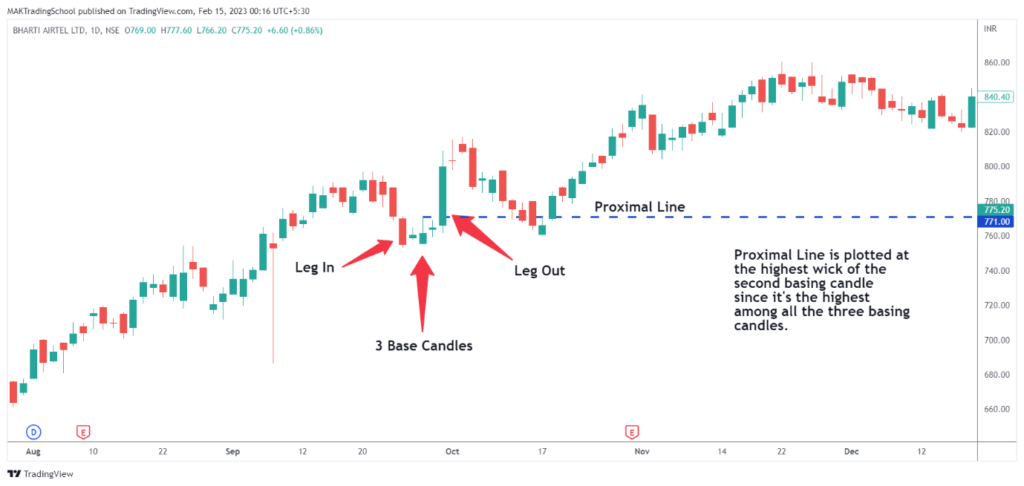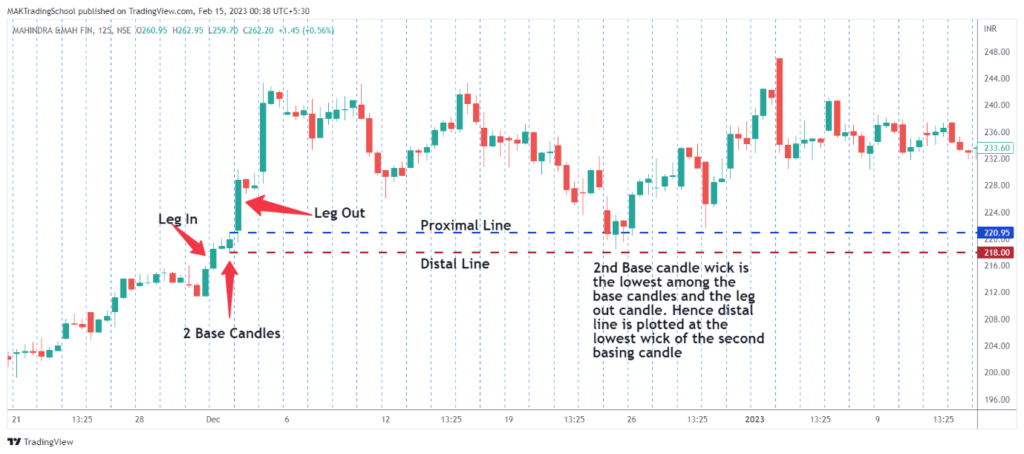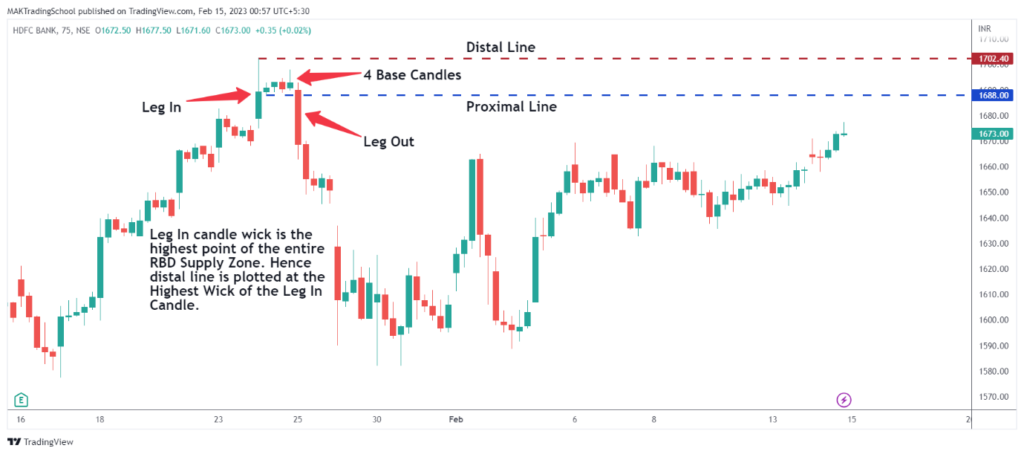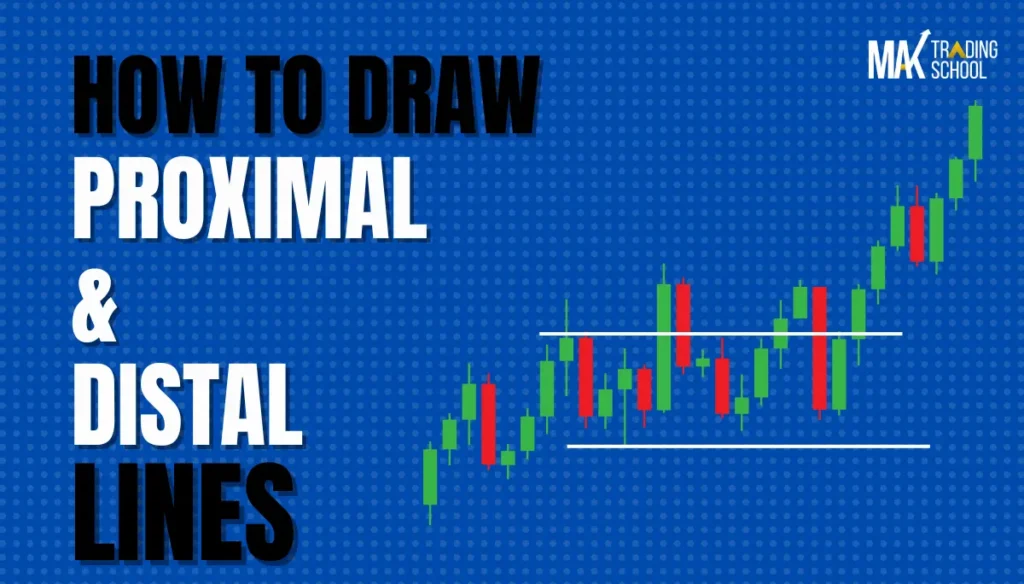How to draw Proximal and Distal lines
Proximal and Distal lines are important components of any Supply and Demand zone. One needs to plot two horizontal lines to mark Supply and Demand Zones. To know How to draw these lines, you need to understand Supply and Demand Zone formations.
Proximity means nearest to the current price, while distal means farthest from the current price.
What is the need to draw Proximal and Distal lines on a zone?
As a Supply and Demand trader, one needs to know which price point to enter and where to exit.
The proximal line is used to define the entry point into a trade, and the Distal line defines the Stopping Point. We place our stop losses slightly beyond the distal lines of the zones.
Also Read: Gap Trading Strategies
Proximal Lines and Distal Lines

Have a look at the above image
Supply zones are located above current market price and Demand zones are located below current market price.
In the illustration above, CMP is Rs.180.
Green shaded zone below CMP is the Demand zone. It has two horizontal lines one at Rs.150 which is nearer to current price, and it forms the proximal line, whereas the other horizontal line is at Rs.140 which is far away as compared to Rs.150, so it constitutes the distal line of demand zone
Pink shaded zone above CMP is the Supply zone. It has two horizontal lines one at Rs.200 which is nearer to current price, and it forms the proximal line, whereas the other horizontal line is at Rs.215 which is far away as compared to Rs.200, so it constitutes the distal line of Supply zone
How to Draw Proximal and Distal Lines for a Demand Zone
A Demand zone is a designated area on a chart where Demand exceeds Supply, and there is a high likelihood of having pending Institutional Buy Orders. We look to enter long trades when price retraces back to the demand zone, in doing so we also participate along with the Institutions which increases the probability of the trade working on our favour. So it’s important to correctly identify Proximal line and Distal line of a Demand Zone. Let u see how to mark Proximal and Distal line of a Demand Zone
Proximal Line Marking For A Demand Zone
Irrespective whether it’s a DBR or RBR Demand zone,proximal line marking method remains the same.There are multiple ways to mark proximal lines, I will discuss the one that I follow and is widely used. While marking the proximal line we look at only the Base Candles, Proximal line is plotted at the Highest Wick of the base candles.

Distal Line Marking for A Demand Zone
There is a slight variation while marking distal lines, depending upon whether it’s a DBR or RBR Demand Zone
Distal Line For DBR Demand Zone
We need to consider all three components, Leg In, Base Candles & Leg Out. Distal line is plotted at the lowest point of the entire formation.

Distal Line For RBR Demand Zone
We need to ignore the Leg In, focus only on the Base candles and the Leg Out. Distal line is plotted at the lowest point of either the Base candles or the Leg Out, whichever is lower.

How to Draw Proximal and Distal Lines for a Supply Zone
A Supply zone is a designated area on a chart where Supply exceeds Demand, and there is a high likelihood of having pending Institutional Sell Orders. We look to enter Short trades when price retraces back to the supply zone, in doing so we also participate along with the Institutions which increases the probability of the trade working on our favour. So it’s important to correctly identify Proximal line and Distal line of a Supply Zone. Let u see how to mark Proximal and Distal line of a Supply Zone
Proximal Line Marking For A Supply Zone
Irrespective whether it’s a RBD or DBD Supply zone,proximal line marking method remains the same.There are multiple ways to mark proximal lines, I will discuss the one that I follow and is widely used. While marking the proximal line we look at only the Base Candles, Proximal line is plotted at the Lowest Wick of the base candles.

Distal Line Marking For A Supply Zone
There is a slight variation while marking distal lines, depending upon whether it’s a RBD or DBD Supply Zone
Distal Line For RBD Supply Zone
We need to consider all three components, Leg In, Base Candles & Leg Out. Distal line is plotted at the highest point of the entire formation.

Distal Line For DBD Supply Zone
We need to ignore the Leg In, focus only on the Base candles and the Leg Out. Distal line is plotted at the Highest point of either the Base candles or the Leg Out, whichever is Higher.

ALSO read: Supply and Demand Zone Indicator
Learn Supply and Demand Trading with our Trading Mantra Workshop, Start your Professional Trading Journey
Conclusion
In conclusion, the Proximal and Distal lines are critical components of the Supply and Demand Trading Strategy. Knowing how to properly place them is essential for successful trading. MAK Trading School’s Core Strategy Program is designed to help aspiring traders gain the knowledge and skills they need to master this strategy and become profitable traders. With the right training, traders can develop the skills they need to succeed in the world of supply and demand trading.
www.maktradingschool.com
Call us on 7400088842
Email:support@maktradingschool.com












